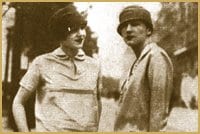“Of course I knew the Nazis condemned homosexuality, and in light of that I kept a low profile,” says Elisabeth Zimmerman. “It was hardly ever spoken about. We protected ourselves instinctively. We isolated ourselves and conducted ourselves accordingly; we were cautious.”
Zimmerman is one of 10 women interviewed by Claudia Schoppmann in her book on queer women and the Holocaust, Days of Masquerade. At a Nov 5 appearance in Toronto for Holocaust Education Week, the Berlin-based historian talked about the difficulties of such research.
“Even 60 years after the end of the war, our knowledge of the lives of lesbian women [during] the Third Reich is sketchy,” she says. “For decades, the public took no interest in the subject, partly because lesbians were not among the declared enemies of the Nazi regime and partly because after 1945 there was no change in attitudes toward homosexuality in either East or West Germany. Discrimination simply continued.
“In this atmosphere of silence, the women who had lived through the Nazi period were not encouraged to talk about their experiences,” Schoppmann explains. “Furthermore, hardly any relevant files or documents have survived.”
First published in German in 1993 and in English three years later, Days of Masquerade is billed as “the first in-depth account of lesbians living in Germany during the Third Reich.” Schoppmann began the research that became the basis of the book while working on her thesis about Anna Elisabet Weirauch’s Der Skorpion (The Scorpion), a three-volume lesbian novel set in Weimer Republic-era Berlin.
As she details in Days of Masquerade, women started to join queer-focused groups such as the Scientific Humanitarian Committee following World War I. Founded by Magnus Hirschfeld in 1897, the main objectives of the group were to repeal Paragraph 175 of the German Criminal Code, which made male homosexuality illegal, and to educate the public about homosexuality.
During this time, several lesbian magazines–including Frauenliebe (Women’s Love), Die Freundin (The Girlfriend) and Garconne–were published. Schoppmann’s research indicates that their combined circulation was in the millions. She also points out that during this time there “were many clubs and bars specifically for, or at least tolerant of, a lesbian clientele.”
All that quickly changed when the Nazis came to power in 1933 and the fledgling homosexual organizations were dissolved.
“[Queer] bars and clubs were closed or kept under surveillance,” writes Schoppmann. “Books and magazines with homosexual content were collected and destroyed.”
But although gay men were actively rounded up and sent to concentration camps along with other declared enemies of the Nazi regime, lesbians were largely considered beneath notice.
“Gender-specific treatment with respect to homosexuality was based on the different assessment of male and female sexuality in general and can be traced back to the unequal status of men and women,” writes Schoppmann. “The Nazi state assumed that women were ‘naturally’ dependent on men, especially in terms of sexuality, and efforts were made to reinforce this as far as possible.
“Based on a centuries-old patriarchal tradition that declared passivity a female trait, a self-assured sense of female sexuality, including homosexuality, was unfathomable. All of this led a majority of Nazis to believe that female sexuality did not represent a threat to the ‘German national community.'”
Schoppmann says very little new information has become available since Days of Masquerade was published. Although an exhibit on the subject was prepared in Hamburg, she says she’s unaware of the findings because there wasn’t funding to actually mount the exhibit.
As such, Schoppmann’s interviews for her 1993 book remain among the few recorded accounts of lesbian life in Nazi Germany.
One interviewee, named Anneliese “Johnny” W, told Schoppmann about a “girlfriend couple” she knew who got fired from their factory jobs presumably for being queer. Although Johnny kept her hair short, she said some of her friends changed their appearance to pass as straight–or got married–in order to be less vulnerable.
Another interviewee, named Elisabeth Leithauser, told Schoppmann about her membership in the Communist Youth Association. When she and her girlfriend moved into an apartment in 1938 the Gestapo ransacked it.
“The Gestapo was always around for the whole 12 years,” Leithauser recalled, “and even if they did leave us alone, relatively speaking, they could have come back at any moment.”
Artist Gertrude Sandmann told Schoppmann she knew that the Gestapo was coming for her because she was Jewish. She left a fake suicide note for those who arrived at her apartment in November 1942 and with the help of her partner of 15 years, Hedwig “Johnny” Koslowski, survived underground until Berlin was liberated.

 Why you can trust Xtra
Why you can trust Xtra


